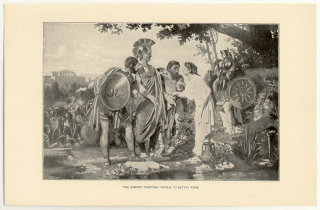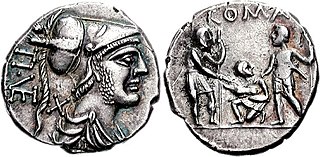Related Research Articles

In Roman mythology, Tarpeia, daughter of the Roman commander Spurius Tarpeius, was a Vestal virgin who betrayed the city of Rome to the Sabines at the time of their women's abduction for what she thought would be a reward of jewellery. She was instead crushed to death and her body cast from the southern cliff of Rome's Capitoline Hill, thereafter called after her the Tarpeian Rock.
Titus Lartius, surnamed either Flavus or Rufus, was one of the leading men of the early Roman Republic, twice consul and the first Roman dictator.

The gens Tarquinia was a plebeian family at ancient Rome, usually associated with Lucius Tarquinius Priscus and Lucius Tarquinius Superbus, the fifth and seventh Kings of Rome. Most of the Tarquinii who appear in history are connected in some way with this dynasty, but a few appear during the later Republic, and others from inscriptions, some dating as late as the fourth century AD.
The gens Carvilia was a plebeian family at ancient Rome, which first distinguished itself during the Samnite Wars. The first member of this gens to achieve the consulship was Spurius Carvilius Maximus, in 293 BC.

The gens Veturia, originally Vetusia, was an ancient patrician family of the Roman Republic. According to tradition, the armourer Mamurius Veturius lived in the time of Numa Pompilius, and made the sacred ancilia. The Veturii occur regularly in the Fasti Consulares of the early Republic, with Gaius Veturius Geminus Cicurinus holding the consulship in 499 BC. Like other old patrician gentes, the Veturii also developed plebeian branches. The family declined in the later Republic, with the last consular Veturius holding office in 206 BC, during the Second Punic War.
The gens Cluvia was a plebeian family at Ancient Rome, known from the later Republic, and early imperial times. The first member of the gens to achieve prominence was Gaius Cluvius Saxula, praetor in 175 and 173 BC.

The gens Sicinia was a plebeian family at ancient Rome. Members of this gens occur throughout the history of the Republic, but only one of them obtained the consulship, Titus Sicinius Sabinus in 487 BC. Throughout the long Conflict of the Orders, the Sicinii were celebrated for their efforts on behalf of the plebeians.

In Roman mythology, the Battle of the Lacus Curtius was the final battle in the war between the Roman Kingdom and the Sabines following Rome's mass abduction of Sabine women to take as brides. It took place during the reign of Romulus, near the Lacus Curtius, future site of the Roman Forum.
The gens Nautia was an old patrician family at Rome. The first of the gens to obtain the consulship was Spurius Nautius Rutilus in 488 BC, and from then until the Samnite Wars the Nautii regularly filled the highest offices of the Roman Republic. After that time, the Nautii all but disappear from the record, appearing only in a handful of inscriptions, mostly from Rome and Latium. A few Nautii occur in imperial times, including a number who appear to have been freedmen, and in the provinces.
The gens Numicia was an ancient patrician family at Rome. The first of the Numicii to appear in history was Titus Numicius Priscus, consul in 469 BC. Later members of the family were plebeian. Members of this gens are first mentioned down to imperial times, and the nomen Numicius is regularly confused with Numisius, which was probably nothing more than a different form of the same gentile name.
The gens Opsidia or Obsidia was a minor plebeian family at ancient Rome. Few members of this gens are known to have held any magistracies, but several are found in inscriptions.
The gens Oscia was an obscure plebeian family at Rome. Members of this gens are first mentioned in imperial times, when a few of them appear among the Roman aristocracy. None of them are known to have held any magistracies, but an Oscia Modesta was the wife of a Roman consul during the time of Severus Alexander. A number of Oscii appear in inscriptions.
The lex Aternia Tarpeia was a Roman law, introduced by the consuls Aulus Aternius Varus and Spurius Tarpeius Montanus Capitolinus in 454 BC, and passed during their year of office. The law concerned the regulation of payments for fines and penalties.
The gens Quirinia was an obscure plebeian family at ancient Rome. No members of this gens appear in history, but several are known from inscriptions.
The gens Rabuleia was a minor plebeian family at ancient Rome. Members of this gens are first mentioned in the early decades of the Republic, and Manius Rabuleius was a member of the second decemvirate in 450 BC. However, the Rabuleii subsequently fell into obscurity, and only a few of this family are known from later inscriptions.
The gens Terentilia was an obscure plebeian family at ancient Rome. Only one member of this gens appears in history; Gaius Terentilius Arsa was tribune of the plebs in 462 BC. A few others are known from inscriptions.
The gens Resia was an obscure plebeian family at ancient Rome. The Resii traced their ancestry to Fertor Resius, King of the Aequicoli, in the time of the Roman monarchy. However, few members of this gens are mentioned in history.
The gens Romilia or Romulia was a minor patrician family at ancient Rome. Members of this gens are mentioned in the time of the Roman monarchy, and again in the first century of the Republic. Titus Romilius Rocus Vaticanus was consul in 455 BC, and subsequently a member of the first Decemvirate in 451. From this time, the Romilii fell into obscurity for centuries, only to appear briefly in imperial times. A number of Romilii are known from inscriptions.
The gens Scantia was a minor plebeian family at ancient Rome. Few members of this gens occur in history, and none of them attained any of the higher offices of the Roman state, but a number are known from inscriptions.
The gens Spurilia, sometimes spelled Spurillia, was an obscure plebeian family at ancient Rome. Hardly any members of this gens are mentioned by ancient writers, for the Spurilius mentioned in some manuscripts of Livy as tribune of the plebs in 422 BC is amended by some authorities to "Spurius Icilius", while it is uncertain whether the moneyer who issued denarii in 139 BC was named Spurius, Spurilius, or Spurinna. Nevertheless, a number of Spurilii are known from inscriptions.
References
- ↑ Dictionary of Greek and Roman Biography and Mythology, vol. III. p. 976 ("Tarpeia", "Tarpeia Gens").
- ↑ Chase, pp. 120, 121.
- ↑ Chase, p. 114.
- ↑ New College Latin & English Dictionary, s. v. valens.
- ↑ Chase, p. 111.
- 1 2 Livy, i. 11.
- ↑ Dionysius, ii. 38–40.
- ↑ Plutarch, "The Life of Numa", 10.
- 1 2 3 Fasti Capitolini, AE 1900, 83; 1904, 114.
- ↑ Livy, iii. 31, 50, 55.
- ↑ Dionysius, x. 48, 50.
- ↑ Broughton, vol. I, pp. 42, 43, 49, 50.
- ↑ CIL III, 9354.
- ↑ CIL VI, 1765.